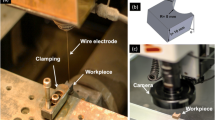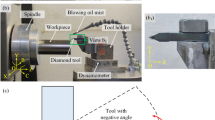Abstract
Tungsten alloys have excellent properties such as high strength, high hardness, high melting point, and high specific gravity, which have been widely used in many cutting-edge scientific fields such as aerospace and military. In order to solve the problems of poor surface quality and severe tool wear in tungsten alloy cutting, conventional dry turning and electroplastically assisted dry turning with different electrical parameters were carried out to study the effects of electroplasticity on surface roughness, surface defects, tool wear, and chip morphology of W93NiFe alloy. The results showed that the electroplastically assisted dry turning process improved the surface quality of W93NiFe alloy. The surface roughness value decreases gradually with the increase of pulse voltage and reaches the minimum value at the pulse voltage of 80 V, with the maximum reduction of 38.94% compared with conventional dry turning. However, too high pulse voltage causes an increase in the surface roughness value. When the pulse voltage was increased from 80 to 90 V, the surface roughness increased by 29.63%. At a pulse voltage of 70 V, the surface roughness value did not change much for different pulse current frequency conditions. Compared to conventional dry turning, electroplastically assisted cutting reduced the degree of machined surface defects in the material and tool wear, but it could lead to the formation of built-up edge at the tool tip. After the pulsed current was applied, the chip curl radius and pitch were smaller, and it was easier to form strip chips with longer transverse lengths. The results provide a reliable reference for electroplastically assisted cutting in the future.






Similar content being viewed by others
References
Yu C (2015) Impact experimental and nanoscopic mechanical simulation investigation of tungsten alloy for penetrator. In: Dissertation. Beijing Institute of Technology
Sagar CK, Priyadarshini A, Gupta AK (2021) Experimental investigations on the effect of tungsten content on the machining behaviour of tungsten heavy alloys. Def Sci J 71(2):162–170. https://doi.org/10.14429/dsj.71.15857
Huang Y, Zhou X, Hua N, Que W, Chen W (2018) High temperature friction and wear behavior of tungsten-copper alloys. Int J Refract Metal Hard Mater 77:105–112. https://doi.org/10.1016/j.ijrmhm.2018.08.001
Liu J, Zhang K (2016) Influence of electric current on superplastic deformation mechanism of 5083 aluminium alloy. Mater Sci Technol 32(6):540–546. https://doi.org/10.1179/1743284715Y.0000000120
Magargee J, Morestin F, Cao J (2013) Characterization of flow stress for commercially pure titanium subjected to electrically assisted deformation. J Eng Mater Technol 135(4):41003–41003. https://doi.org/10.1115/1.4024394
Liu K, Dong X, Xie H, Peng F (2015) Effect of pulsed current on the deformation behavior of AZ31B magnesium alloy. Mater Sci Eng, A 623:97–103. https://doi.org/10.1016/j.msea.2014.11.039
Xie H, Dong X, Liu K, Ai Z, Peng F, Wang Q, Chen F, Wang J (2015) Experimental investigation on electroplastic effect of DP980 advanced high strength steel. Mater Sci Eng, A 637:23–28. https://doi.org/10.1016/j.msea.2015.04.016
Ross CD, Irvin DB, Roth JT (2007) Manufacturing aspects relating to the effects of direct current on the tensile properties of metals. J Eng Mater Technol 129(2):342–347. https://doi.org/10.1115/1.2712470
Ruszkiewicz BJ, Grimm T, Ragai I, Mears L, Roth JT (2017) A review of electrically-assisted manufacturing with emphasis on modeling and understanding of the electroplastic effect. J Manufac Sci Eng 139(11):110801–110816. https://doi.org/10.1115/1.4036716
Zheng MX, Zhu YH, Tang GY (1998) Comments on electroplastic drawing and its structure evolution. Journal of Tsinghua University (Science and Technology) 38(02):30–34. https://doi.org/10.16511/j.cnki.qhdxxb.1998.02.008
Deng H, Dong XH (2019) Influence of electroplastic effect on forming limit of 5A90 Al-Li alloy. J Plast Eng 06:114–119. https://doi.org/10.3969/j.issn.1007-2012.2019.06.017
Kim MJ, Lee K, Oh KH, Choi IS, Yu HH, Hong ST, Han HN (2014) Electric current-induced annealing during uniaxial tension of aluminum alloy. Scripta Mater 75:58–61. https://doi.org/10.1016/j.scriptamat.2013.11.019
Andre D, Burlet T, Körkemeyer F, Gerstein G, Gibson JL, Sandlöbes-Haut S, Korte-Kerzel S (2019) Investigation of the electroplastic effect using nanoindentation. Mater Des 183:108153. https://doi.org/10.1016/j.matdes.2019.108153
Shi W, Dong XH (2019) Multi-physical field coupled analysis of electric current assisted tension of AZ31B magnesium alloy. J Plast Eng 06:106–113. https://doi.org/10.3969/j.issn.1007-2012.2019.06.016
Sun LN, Li Q, Li M (2020) Experimental study on electro-plastic effect in affect duration of single electric pulse in rolling. J Plast Eng 10:21–26. https://doi.org/10.3969/j.issn.1007-2012.2020.10.004
Tian HY, Tang GY, Ding F, Xu ZH, Jiang YB (2017) Research on electroplastic drawing of Mg-alloy wire. Nonferrous Metals Eng 2:10–13. https://doi.org/10.3969/j.issn.2095-1744.2007.02.003
Ghiotti A, Bruschi S, Simonetto E, Gennari C, Calliari I, Bariani P (2018) Electroplastic effect on AA1050 aluminium alloy formability. CIRP Ann 67(1):289–292. https://doi.org/10.1016/j.cirp.2018.04.054
Li DL, Li YT, Yu EL, Han Y, Liu F (2018) Theoretical and experimental study of the drawing force under a current pulse. Int J Adv Manufac Technol 97(1):1047–1051. https://doi.org/10.1007/s00170-018-1896-y
Qian L, Zhan L, Zhou B, Zhang X, Liu S, Lv Z (2021) Effects of electroplastic rolling on mechanical properties and microstructure of low-carbon martensitic steel. Mater Sci Eng, A 812:141144. https://doi.org/10.1016/j.msea.2021.141144
Huang HC, Liu MJ, Sun M, Jiang P (2021) Microstructure and properties of V-Ti-Ni alloy for hydrogen separation treated by electroplastic rolling. Heat Treat Metals 46(3):153–158. https://doi.org/10.13251/j.issn.0254-6051.2021.03.031
Zhao Y, Peng L, Lai X (2018) Influence of the electric pulse on springback during stretch U-bending of Ti6Al4V titanium alloy sheets. J Mater Process Technol 261:12–23. https://doi.org/10.1016/j.jmatprotec.2018.05.030
Lv Z, Zhou Y, Zhan L, Zang Z, Zhou B, Qin S (2021) Electrically assisted deep drawing on high-strength steel sheet. Int J Adv Manufac Technol 112(3):763–773. https://doi.org/10.1007/s00170-020-06335-1
Potapova AA, Resnina NN, Stolyarov VV (2014) Shape memory effects in TiNi-based alloys subjected to electroplastic rolling. J Mater Eng Perform 23(7):2391–2395. https://doi.org/10.1007/s11665-014-1046-0
Liu DD (2019) Suppression of edge crack of cold rolled magnesium alloy by high pulse current and its mechanism analysis. Dissertation, Yanshan University. https://doi.org/10.27440/d.cnki.gysdu.2019.000562
Song H, Wang ZJ (2013) Improvement in formability of TiAl and Ti alloys by high density electropulsing. Mater Sci Technol 21(05):117–124. https://doi.org/10.11951/j.issn.1005-0299.20130520
Li XF, Jiao GP, Jiang J, Chen J (2019) Effect of pulse current frequency on mechanical properties of TC4 titanium alloy with prefabricated defects. Rare Metal Mater Eng 48(8):2655–2660
Huang BT, Gao YF (2020) Experimental study on electroplasticity assisted milling of GH4169 superalloy. J Plast Eng 27(12):82–87. https://doi.org/10.3969/j.issn.1007-2012.2020.12.012
Ulutan D, Pleta A, Mears L (2015) Electrically-assisted machining of titanium alloy ti-6Al-4V and nickel-based alloy IN-738: an investigation. International Manufacturing Science and Engineering Conference: American Society of Mechanical Engineers 56826:V001T02A013. https://doi.org/10.1115/MSEC2015-9465
Ruszkiewicz BJ, Gendreau E, Niaki FA, Mears L (2018) Electroplastic drilling of low-and high-strength steels. J Manuf Sci Eng 140(6):1017–1031. https://doi.org/10.1115/1.4039648
Ruszkiewicz BJ, Akhavan Niaki F, Mears L, Gendreau E (2017) An investigation of electroplastic drilling of mild steel. International Manufacturing Science and Engineering Conference: American Society of Mechanical Engineers 50725: V001T02A013. https://doi.org/10.1115/MSEC2017-2766
Egea AJS, Rojas HAG, Montaña CAM, Echeverri VK (2015) Effect of electroplastic cutting on the manufacturing process and surface properties. J Mater Process Technol 222:327–334. https://doi.org/10.1016/j.jmatprotec.2015.03.018
Zhang S, Wang HB, Zhang B, Song GL, Wang XL, Han L, Tang GY (2018) Effect of electropulsing assisted cutting process on cutting properties of quenched GCr15 bearing steel. Rare Metal Mater Eng 47(2):574–580
Zhao ZF, Qi JG, Wang JZ (2013) Effects of electric pulse treatment on γ phase in silicon brass. Foundry Technol 34(9):1108–1111
Dobras D, Bruschi S, Simonetto E, Rutkowska-Gorczyca M, Ghiotti A (2020) The effect of direct electric current on the plastic behavior of AA7075 aluminum alloy in different states of hardening. Materials 14(1):73. https://doi.org/10.3390/ma14010073
Ye SS, Zhao D, Yang Y, Yang G, Yin DQ, Zhou Y (2017) Flow stress analysis of TC4 titanium alloy during electroplastic effect. Rare Metal Mater Eng 06:1572–1577
Ma R, Zhang XF (2022) Refining the microstructure to strengthen casting titanium alloy by electric pulse. Mater Sci Eng, A 849:143519. https://doi.org/10.1016/j.msea.2022.143519
Wang HB (2016) Research on the electropulsing assisted turning and ultrasonic-electropulsing coupling surface process for the 304 stainless steel. Dissertation, Tsinghua University
Zhou YZ, Zeng Y, He GH, Zhou BL (2001) The healing of quenched crack in 1045 steel under electropulsing. J Mater Res 16(1):17–19. https://doi.org/10.1557/JMR.2001.0005
Qin R, Su S (2002) Thermodynamics of crack healing under electropulsing. J Mater Res 17(8):2048–2052. https://doi.org/10.1557/JMR.2002.0303
Wang CH (2021) Micro wear mechanism of TiAlN coated carbide tool in 93W machining. Dissertation, Southwest Jiaotong University. https://doi.org/10.27414/d.cnki.gxnju.2021.000620
Wang H, Chen L, Liu D, Song G, Tang G (2015) Study on electropulsing assisted turning process for AISI 304 stainless steel. Mater Sci Technol 31(13):1564–1571. https://doi.org/10.1179/1743284715Y.0000000034
Funding
This work was supported by the National Natural Science Foundation of China (52175431).
Author information
Authors and Affiliations
Contributions
All authors contributed to the study conception and design. Material preparation, data collection, and analysis were performed by Lixiang Zhao, Guangjun Chen, Jie Liu, Hong Wei, and Jiashuai Huang. The first draft of the manuscript was written by Lixiang Zhao, and all authors commented on previous versions of the manuscript. All authors read and approved the final manuscript.
Corresponding author
Ethics declarations
Competing interests
The authors declare no competing interests.
Additional information
Publisher's note
Springer Nature remains neutral with regard to jurisdictional claims in published maps and institutional affiliations.
Rights and permissions
Springer Nature or its licensor (e.g. a society or other partner) holds exclusive rights to this article under a publishing agreement with the author(s) or other rightsholder(s); author self-archiving of the accepted manuscript version of this article is solely governed by the terms of such publishing agreement and applicable law.
About this article
Cite this article
Zhao, L., Chen, G., Liu, J. et al. Effect of pulse current parameters on electroplastically assisted dry cutting performance of W93NiFe alloy. Int J Adv Manuf Technol 131, 2123–2131 (2024). https://doi.org/10.1007/s00170-022-10762-7
Received:
Accepted:
Published:
Issue Date:
DOI: https://doi.org/10.1007/s00170-022-10762-7




